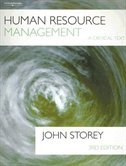Bestselling Books
|
Bestselling Books |
|
| US Bestsellers UK Bestsellers France - Meilleurs Ventes Canada Bestsellers Germany Bestsellers |
 Hooked on books? BestBooks.biz features book-related articles, book extracts and book selections from the best books - past and present.  Human Resources Management: A Critical Text, 3eJohn Storey (editor)Designed to meet the needs of advanced management students on a variety of courses, the international team of expert contributors provides an in-depth, authoritative, critical and original account of contemporary HRM More information and prices from: Amazon.com - US dollars Amazon.ca - Canadian dollars Amazon.co.uk - British pounds Amazon.de - Euros Amazon.fr - Euros |
HRM approaches and modelsAdapted from Human Resource Management in a Business Context, 3rd edition (2007) Keenoy (1999) compares HRM with a hologram: "As with a hologram, HRM changes its appearance as we move around its image. Each shift of stance reveals another facet, a darker depth, a different contour. As a fluid entity of apparently multiple identities and forms, it is not surprising that every time we look at it, it is slightly different. This is why, conceptually, HRMism appears to be a moving target, and why, empirically, it has no fixed (fixable) forms." Not surprisingly, you will find a multiplicity of interpretations, some in the shape of formal models. The two most influential are the Harvard and Michigan models from the 1980s. More recently, 'best practice' approaches have featured of which the most significant have been by Pfeffer and Ulrich. Pfeffer argues - in a series of books - that the greatest competitive advantage is to be obtained from people rather than technology. He contends that investment in technology is not enough, because that technology is (or soon will be) available to competitors. And the more complex the technology - the more it requires people skills anyway. Instead we need that variant of HRM described as 'high-performance management' (US) or 'high-commitment management' (elsewhere). Classifications of HRM models
Cakar and Bititci (2001) argue that whereas a number of authors have attempted to classify the various models of HRM using terms such as 'descriptive', 'normative' and 'prescriptive', they do not offer precise definitions of these terms. They identify two sources of confusion: * Confusion over different types of classification, e.g. is there a difference between 'normative' (Legge, 1995)
and 'prescriptive' (Storey, 1994).
Storey (2001) argues that HRM is 'an amalgam of description, prescription and logical deduction' and that it is a 'historically-situated phenomenon.' He considers that it arose when confidence had been lost in more traditional approaches to people management because of new levels and types of competition. Moreover, for Storey, HRM reflects the beliefs and assumptions of influential 'leading-edge' practitioners. References: Cakar, F. and Bititci, U.S. (2001) Human Resource Management as a Strategic Input to Manufacturing paper presented at the International Working Conference on Strategic Manufacturing 26-29 August 2001, Aalborg, Denmark. Keenoy, T. (1999), 'HRM as hologram: a polemic', Journal of Management Studies 36(1): 1-23. Storey, J. (ed) (2001), Human Resources Management: A Critical Text, 3e, Thomson Learning. This article is based on Human Resource Management in a Business Context by Alan Price (3rd edition, 2007) . |
 in a Business Context by Alan Price
|
|
|
|
|
|
|
|
|
| Copyright © 2000-20l7 Alan Price and BestBooks.biz contributors. All rights reserved. |